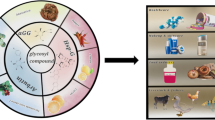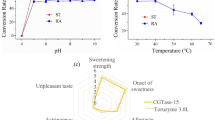Abstract
The taste quality of steviol glycosides (SG) is highly dependent on the numbers and linkages of glucosyl units connecting to its diterpenoid core. In this work, the transglycosylation of stevioside (ST) catalyzed by cyclodextrin glucanotransferase were optimized initially. At a high conversion rate of ~ 65%, a mixture of ST derivatives was produced by adding 1– 6 glucosyl units to the ST molecule. By further treatment with α-glucosidase for 4– 24 h, the length of the glucosyl chain can be reduced to 1– 2 units. Based on a previous investigation, the SG recovered from the mother liquor of stevia production was used as the substrate. Taste quality evaluation on the obtained glucosyl steviol glycosides (GSG) suggested both the sweet and bitter aftertaste were significantly weakened after transglycosylation. The sweetness of GSG was obviously reduced with the increase in glucosyl-chain length, while the licorice flavor caused by the residual polyphenols can also be weakened after enzymatic modification. The GSG products presented unique taste quality different from rebaudioside A (RA) and rebaudioside M (RM), while their overall taste quality was close to that of RM. Conclusively, the research can provide a clean approach to promote the resource utilization of stevia, and new GSG products with improved taste quality can be the potential sweetener for food manufacture.







Similar content being viewed by others
Abbreviations
- SG:
-
Steviol glycoside
- MLS:
-
Mother liquor sugar
- ST:
-
Stevioside
- RA:
-
Rebaudioside A
- RC:
-
Rebaudioside C
- RD:
-
Rebaudioside D
- RM:
-
Rebaudioside M
- GSG:
-
Glucosyl steviol glycosides
- RSG:
-
Recovered SG from MLS
- CGTase:
-
Cyclodextrin glycosyltransferase
- HPLC:
-
High-performance liquid chromatography
- LC–MS:
-
Liquid chromatography–mass spectrum
- TIC:
-
Total ion chromatography
- IC:
-
Ionic chromatography
- HPAEC-PAD:
-
High-performance anion-exchange chromatography-pulsed amperometric detector
- SLR:
-
Sold-to-liquid ratio
- RSV:
-
Relative sweetness
- RT:
-
Retention time
- SD:
-
Standard deviation
- LSD:
-
Least significant difference
- PCA:
-
Principal component analysis
References
Devlamynck T, Te Poele EM, Quataert K, Gerwig GJ, Van de Walle D, Dewettinck K, Dijkhuizen L (2019) Trans-α-glucosylation of stevioside by the mutant glucansucrase enzyme Gtf180-ΔN-Q1140E improves its taste profile. Food Chem 272:653–662
Evans JC, Hahn JJ, Myerson AS, Oolman T, Rhonemus TA, Storo KM, Tyler CA (2015) U.S. Patent No. 8,937,168. Washington, DC: U.S. Patent and Trademark Office.
Guo Q, Zhang T, Wang N, **a Y, Zhou Z, Wang JR, Mei X (2019) RQ3, a natural rebaudioside D isomer, was obtained from glucosylation of rebaudioside A catalyzed by the CGTase Toruzyme 3.0 L. J Agric Food Chem 67(28):8020–8028
Hellfritsch C, Brockhoff A, Stähler F, Meyerhof W, Hofmann T (2012) Human psychometric and taste receptor responses to steviol glycosides. J Agric Food Chem 60(27):6782–6793
Jaitak V (2015) Interaction model of steviol glycosides from Stevia rebaudiana (Bertoni) with sweet taste receptors: A computational approach. Phytochemistry 116:12–20
Jung SW, Kim TK, Lee KW, Lee YH (2007) Catalytic properties of β-cyclodextrin glucanotransferase from alkalophilicBacillus sp. BL-12 and intermolecular transglycosylation of stevioside. Biotechnol Bioproc Eng 12(3):207
Ko JA, Nam SH, Park JY, Wee Y, Kim D, Lee WS, Kim YM (2016) Synthesis and characterization of glucosyl stevioside using Leuconostoc dextransucrase. Food Chem 211:577–582
Lemus-Mondaca R, Vega-Gálvez A, Zura-Bravo L, Ah-Hen K (2012) Stevia rebaudiana Bertoni, source of a high-potency natural sweetener: A comprehensive review on the biochemical, nutritional and functional aspects. Food Chem 132(3):1121–1132
Li S, Li W, **ao QY, **a Y (2013) Transglycosylation of stevioside to improve the edulcorant quality by lower substitution using cornstarch hydrolyzate and CGTase. Food Chem 138(2–3):2064–2069
Liu Y, Hua X, Wang M, Yang R (2019) Purification of the mother liquor sugar from industrial stevia production through one-step adsorption by non-polar macroporous resin. Food Chem 274:337–344
Liu Y, Hua X, Zhang M, Zhou A, Zhou X, Yang R (2021) Recovery of steviol glycosides from industrial stevia by-product via crystallization and reversed-phase chromatography. Food Chem 344:128726
Muñoz-Labrador A, Azcarate S, Lebrón-Aguilar R, Quintanilla-López JE, Galindo-Iranzo P, Kolida S, Hernandez-Hernandez O (2020) Transglycosylation of steviol glycosides and rebaudioside a: synthesis optimization structural analysis and sensory profiles. Foods 9(12):1753
Musa A, Miao M, Zhang T, Jiang B (2014) Biotransformation of stevioside by Leuconostoc citreum SK24. 002 alternansucrase acceptor reaction. Food Chem 146:23–29
Ohta M, Sasa S, Inoue A, Tamai T, Fujita T, Morita K (2010) Characterization of novel steviol glycosides from leaves of Stevia rebaudiana Morita. J Appl Glycosci 57(3):199–209
Prakash I, Campbell M, Chaturvedula VSP (2012) Catalytic hydrogenation of the sweet principles of Stevia rebaudiana, rebaudioside B, rebaudioside C, and rebaudioside D and sensory evaluation of their reduced derivatives. Int J Mol Sci 13(11):15126–15136
Prakash I, Markosyan A, Bunders C (2014) Development of next generation stevia sweetener: Rebaudioside M. Foods 3(1):162–175
Tao R, Cho S (2020) Consumer-based sensory characterization of steviol glycosides (rebaudioside A, D, and M). Foods 9(8):1026
Toyota K, Cui H, Abe K, Habara M, Toko K, Ikezaki H (2011) Sweetness sensor with lipid/polymer membranes: Sweet-responsive substances. Sensors Mater 23(8):465–474
Wölwer-Rieck U (Ed.) (2018) Steviol Glycosides: cultivation, processing, analysis and applications in food (No. 7). Royal Society of Chemistry
Ye F, Yang R, Hua X, Shen Q, Zhao W, Zhang W (2013) Modification of stevioside using transglucosylation activity of Bacillus amyloliquefaciens α-amylase to reduce its bitter aftertaste. LWT-Food Sci Technol 51(2):524–530
Ye F, Yang R, Hua X, Shen Q, Zhao W, Zhang W (2014) Modification of steviol glycosides using α-amylase. LWT-Food Sci Technol 57(1):400–405
Yu X, Yang J, Li B, Yuan H (2015) High efficiency transformation of stevioside into a single mono-glycosylated product using a cyclodextrin glucanotransferase from Paenibacillus sp CGMCC 5316. World J Microbiol Biotechnol 31(12):1983–1991
Zerva A, Chorozian K, Kritikou AS, Thomaidis NS, Topakas E (2021) β-glucosidase and β-GALACTOSIDASE-MEDIATED TRANSGLYCOSYLATION OF STEVIOL GLYCOSIDES UTILIZING INDUSTRIAL BYPROducts. Front Bioeng Biotechnol 9:444
Acknowledgements
We are grateful for the financial support from the Foundation of Science and Technology of Jiangsu Province (BE2021309 & BE2020402).
Author information
Authors and Affiliations
Corresponding author
Ethics declarations
Conflict of interest
The authors confirm that they have no conflicts of interest with respect to the work described in this manuscript.
Compliance with ethics requirements
All procedures performed in studies involving human participants were in accordance with the ethical standards of the institutional and national research committee and with the 1964 Helsinki declaration and its later amendments or comparable ethical standards.
Additional information
Publisher's Note
Springer Nature remains neutral with regard to jurisdictional claims in published maps and institutional affiliations.
Supplementary Information
Below is the link to the electronic supplementary material.
Rights and permissions
About this article
Cite this article
Wang, Z., Yuan, Y., Liu, Y. et al. Modification on the length of glucosyl chain in glucosyl steviol glycosides and its effect on product taste quality. Eur Food Res Technol 248, 1703–1713 (2022). https://doi.org/10.1007/s00217-022-03997-x
Received:
Revised:
Accepted:
Published:
Issue Date:
DOI: https://doi.org/10.1007/s00217-022-03997-x




